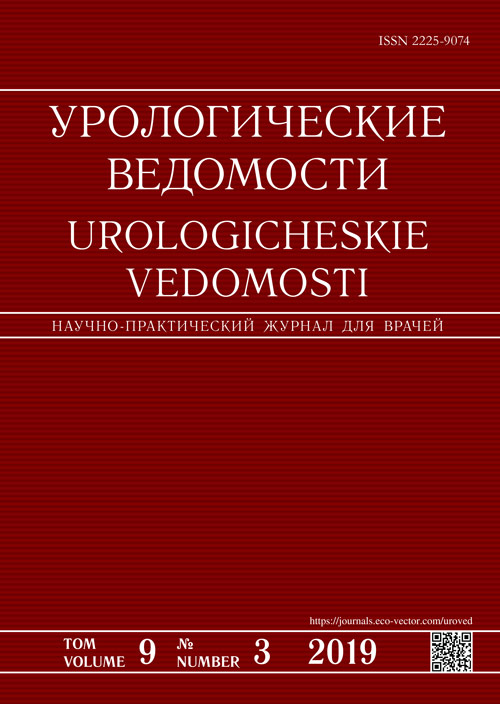Experience of combined pudendal and sacral electrostimulation in a patient with chronic pelvic pain
- Authors: Polushkin A.A.1, Isagulyan E.D.1, Tomskiy A.A.1, Salyukov R.V.2
-
Affiliations:
- N.N. Burdenko National Medical Research Center of Neurosurgery of the Ministry of Health of the Russian Federation
- RUDN University of the Ministry of Science and Higher Education of the Russian Federation
- Issue: Vol 9, No 3 (2019)
- Pages: 57-64
- Section: Сlinical observations
- URL: https://bakhtiniada.ru/uroved/article/view/17708
- DOI: https://doi.org/10.17816/uroved9357-64
- ID: 17708
Cite item
Abstract
Treatment of patients with chronic pelvic pain is one of the most difficult tasks of modern medicine. Recently, surgical neuromodulation has been increasingly used to treat chronic pain syndrome. The positive experience of chronic sacral stimulation usage in patients with pelvic organ dysfunction accompanied by pain syndrome determines the appropriateness of further search for effective methods of chronic pelvic pain treatment, for example, its combination with stimulation of peripheral nerves. The article presents a clinical observation of a patient suffering from chronic pelvic pain for a long time, who underwent chronic electrical stimulation of the sacral roots in combination with sacral nerve stimulation. After the first year of treatment, a decrease in pain intensity on the visual analog scale from 8 to 3 points, depression on the Zips from 14 to 10 points and a decrease in the indicator on the anxiety scale from 14 to 11 points was observed. The patient’s quality of life was improved, pain attacks were decreased, daily motor activity was increased, self-service along with social communication indicators were improved and the need for medicines was decreased.
Full Text
##article.viewOnOriginalSite##About the authors
Andrey A. Polushkin
N.N. Burdenko National Medical Research Center of Neurosurgery of the Ministry of Health of the Russian Federation
Author for correspondence.
Email: a_pol83@mail.ru
neurosurgeon
Russian Federation, MoscowEmil D. Isagulyan
N.N. Burdenko National Medical Research Center of Neurosurgery of the Ministry of Health of the Russian Federation
Email: eisagulyan@nsi.ru
Candidate of Medical Science, Neurosurgeon, Senior Research Fellow
Russian Federation, MoscowAleksey A. Tomskiy
N.N. Burdenko National Medical Research Center of Neurosurgery of the Ministry of Health of the Russian Federation
Email: atomski@nsi.ru
Candidate of Medical Science, Neurosurgeon, Senior Research Fellow
Russian Federation, MoscowRoman V. Salyukov
RUDN University of the Ministry of Science and Higher Education of the Russian Federation
Email: salyukov2012@yandex.ru
Candidate of Medical Science, Urologist, Associate Professor, Department of Endoscopic Urology
Russian Federation, MoscowReferences
- Зайцев А.В., Шаров М.Н., Пушкарь Д.Ю., и др. Хроническая тазовая боль. – М.: АБВ-пресс, 2016. – 43 с. [Zaytsev AV, Sharov MN, Pushkar’ DYu, et al. Khronicheskaya tazovaya bol’. Moscow: ABV-press; 2016. 43 р. (In Russ.)]
- Engeler DS, Baranowski AP, Dinis-Oliveira P, et al. The 2013 EAU guidelines on chronic pelvic pain: is management of chronic pelvic pain a habit, a philosophy, or a science? 10 years of development. Eur Urol. 2013;64(3):431-439. https://doi.org/10.1016/j.eururo.2013.04.035.
- IASP. Fellowships, grants, and awards [Internet]. International Association for the Study of Pain; 2018. Available from: http://www.iasp-pain.org/Education/.
- Harris RD, Holtzman SR, Poppe AM. Clinical outcome in female patients with pelvic pain and normal pelvic US findings. Radiology. 2000;216(2):440-443. https://doi.org/10.1148/radiology.216.2.r00au22440.
- Исагулян Э.Д., Шабалов В.А. Хирургическое лечение нейропатических болевых синдромов. Часть 1 // Нейрохирургия. – 2009. – № 2. – С. 5–12. [Isagulyan ED, Shabalov VA. Khirurgicheskoe lechenie neiropaticheskikh bolevykh sindromov. Part 1. Neyrokhirurgiya. 2009;(2):5-12. (In Russ.)]
- Исагулян Э.Д., Шабалов В.А. Методы нейростимуляции в лечении боли // Manage Pain. – 2014. – № 4. – С. 48–54. [Isagulyan ED, Shabalov VA. Metody neyrostimulyatsiy v lecheniy boli. Manage Pain. 2014;(4):48-54. (In Russ.)]
- Zigmond AS, Snaith RP. The hospital anxiety and depression scale. Acta Psychiatr Scand. 1983;67(6):361-370. https://doi.org/10.1111/j.1600-0447.1983.tb09716.x.
- Matzel KE, Chartier-Kastler E, Knowles CH, et al. Sacral neuromodulation: standardized electrode placement technique: neuromodulation. Neuromodulation. 2017;20(8):816-824. https://doi.org/10.1111/ner.12695.
- Heinze K, Hoermann R, Fritsch H, et al. Comparative pilot study of implantation techniques for pudendal neuromodulation: technical and clinical outcome in first 20 patients with chronic pelvic pain. World J Urol. 2015;33(2):289-294. https://doi.org/10.1007/s00345-014-1304-7.
- Hanno PM, Burks DA, Clemens JQ, et al. AUA guideline for the diagnosis and treatment of interstitial cystitis/bladder pain syndrome. J Urol. 2011;185(6):2162-2170. https://doi.org/10.1016/j.juro.2011.03.064.
- Donon L, Robert G, Ballanger P. [Sacral neuromodulation: results of a monocentric study of 93 patients. (In French)]. Prog Urol. 2014;24(17):1120-1131. https://doi.org/10.1016/j.purol.2014.09.037.
- Karasev S, Yakovlev A, Resch B. Sacral nerve stimulation for treatment of perineal pain. European Journal of Pain Supplements. 2011;5(S1):288. https://doi.org/10.1016/S1754-3207(11)70994-4.
- Sokal P, Zieliński P, Harat M. Sacral roots stimulation in chronic pelvic pain. Neurol Neurochir Pol. 2015;49(5):307-312. https://doi.org/10.1016/j.pjnns.2015.07.003.
- Laviana A, Jellison F, Kim JH. Sacral neuromodulation for refractory overactive bladder, interstitial cystitis, and painful bladder syndrome. Neurosurg Clin N Am. 2014;25(1):33-46. https://doi.org/10.1016/j.nec.2013.08.001.
- Martellucci J, Naldini G, Carriero A. Sacral nerve modulation in the treatment of chronic pelvic pain. Int J Colorectal Dis. 2012;27(7):921-926. https://doi.org/10.1007/s00384-011-1394-2.
- Peters KM, Konstandt D. Sacral neuromodulation decreases narcotic requirements in refractory interstitial cystitis. BJU Int. 2004;93(6): 777-779. https://doi.org/10.1111/j.1464-410X.2003.04745.x
- Siegel S, Paszkiewicz E, Kirkpatrick C, et al. Sacral nerve stimulation in patients with chronic intractable pelvic pain. J Urol. 2001;166(5): 1742-5. https://doi.org/10.1097/00005392-200111000-00028.
- Sherman ND, Amundsen CL. Current and future techniques of neuromodulation for bladder dysfunction. Curr Urol Rep. 2007;8(6):448-454. https://doi.org/10.1007/s11934-007-0047-z.
- Fan AK, Peters KM, Buora J. Neuromodulation for chronic urogenital pain: a comparison of pudendal and sacral nerve stimulation. J Urol Suppl. 2017;197:1046-7. https://doi.org/10.1016/j.juro.2017.02.2414.
- Peters KM, Feber KM, Bennett RC. Sacral versus pudendal nerve stimulation for voiding dysfunction: a prospective, single-blinded, randomized, crossover trial. Neurourol Urodyn. 2005;24(7):643-7. https://doi.org/10.1002/nau.20174.
Supplementary files












